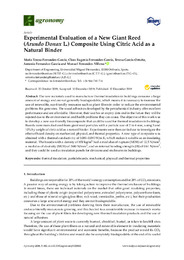Por favor, use este identificador para citar o enlazar este ítem:
https://hdl.handle.net/11000/34596Registro completo de metadatos
| Campo DC | Valor | Lengua/Idioma |
|---|---|---|
| dc.contributor.author | Ferrández-Villena, Manuel | - |
| dc.contributor.author | Garcia-Ortuño, Teresa | - |
| dc.contributor.author | Ferrández García, Clara Eugenia | - |
| dc.contributor.author | FERRANDEZ GARCIA, PATRICIA MARIA | - |
| dc.contributor.author | Ferrández-García, Antonio | - |
| dc.contributor.other | Departamentos de la UMH::Ingeniería | es_ES |
| dc.date.accessioned | 2025-01-16T17:50:17Z | - |
| dc.date.available | 2025-01-16T17:50:17Z | - |
| dc.date.created | 2019 | - |
| dc.identifier.citation | Agronomy | es_ES |
| dc.identifier.issn | 2073-4395 | - |
| dc.identifier.uri | https://hdl.handle.net/11000/34596 | - |
| dc.description.abstract | The raw materials used to manufacture thermal insulation in buildings consume a large amount of energy and are not generally biodegradable, which means it is necessary to increase the use of renewable, eco-friendly resources such as plant fibers in order to reduce the environmental problems this generates. The wood adhesives developed by the petrochemical industry offer excellent performance and are affordable. However, their use has an expiry date and in the future they will be rejected due to the environmental and health problems they can cause. The objective of this work was to develop a new eco-friendly biocomposite that could be used for thermal insulation in buildings. Boards were manufactured from giant reed particles with a particle size of 2 to 4 mm, using 5 and 10% by weight of citric acid as a natural binder. Experiments were then carried out to investigate the effect of board density on mechanical, physical, and thermal properties. A new type of composite was obtained with a thermal conductivity of 0.081–0.093 W/m K, which makes it suitable as an insulating material. The boards with a density of 850 kg/m3 had a modulus of rupture (MOR) of 12.5 N/mm2, a modulus of elasticity (MOE) of 2440 N/mm2, and an internal bonding strength (IB) of 0.61 N/mm2, and they could be used as insulation panels for divisions and enclosures in buildings. | es_ES |
| dc.format | application/pdf | es_ES |
| dc.format.extent | 14 | es_ES |
| dc.language.iso | eng | es_ES |
| dc.publisher | MDPI | es_ES |
| dc.relation.ispartofseries | 9 | es_ES |
| dc.relation.ispartofseries | 12 | es_ES |
| dc.rights | info:eu-repo/semantics/openAccess | es_ES |
| dc.rights | Attribution-NonCommercial-NoDerivatives 4.0 Internacional | * |
| dc.rights.uri | http://creativecommons.org/licenses/by-nc-nd/4.0/ | * |
| dc.subject | thermal insulation | es_ES |
| dc.subject | particleboards | es_ES |
| dc.subject | mechanical | es_ES |
| dc.subject | physical and thermal properties | es_ES |
| dc.subject.other | CDU::6 - Ciencias aplicadas::62 - Ingeniería. Tecnología | es_ES |
| dc.title | Experimental Evaluation of a New Giant Reed (Arundo Donax L.) Composite Using Citric Acid as a Natural Binder | es_ES |
| dc.type | info:eu-repo/semantics/article | es_ES |
| dc.relation.publisherversion | https://doi.org/10.3390/agronomy9120882 | es_ES |

Ver/Abrir:
2019.- Agronomy. Experimental Evaluation.pdf
1,22 MB
Adobe PDF
Compartir:
 La licencia se describe como: Atribución-NonComercial-NoDerivada 4.0 Internacional.
La licencia se describe como: Atribución-NonComercial-NoDerivada 4.0 Internacional.
.png)